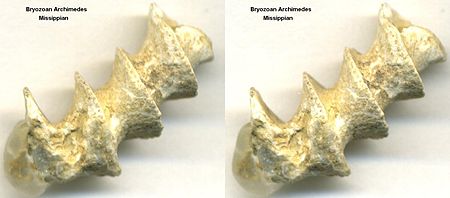Bryozoa
| Bryozoa Temporal range: Early Ordovician–Recent |
|
|---|---|
 |
|
| "Bryozoa", from Ernst Haeckel's Kunstformen der Natur, 1904 | |
| Scientific classification | |
| Kingdom: | Animalia |
| Superphylum: |
Lophotrochozoa |
| Phylum: |
Bryozoa Ehrenberg, 1831 |
| Classes | |
| Synonyms | |
|
Ectoprocta (Nitsche, 1869) (formerly subphylum of Bryzoa) |
|
| Stereo image
|
||
|
||
|
||
|
||
|
||
| Fossilized skeleton of Archimedes Bryozoan |
Ectoprocta (Nitsche, 1869) (formerly subphylum of Bryzoa)
Bryozoa (also known as the Polyzoa, Ectoprocta or commonly as moss animals), are a phylum of aquatic invertebrate animals. Typically about 0.5 millimetres (0.020 in) long, they are filter feeders that sieve food particles out of the water using a retractable lophophore, a "crown" of tentacles lined with cilia. Most marine species live in tropical waters, but a few occur in oceanic trenches, and others are found in polar waters. One class lives only in a variety of freshwater environments, and a few members of a mostly marine class prefer brackish water. Over 4,000 living species are known. One genus is solitary and the rest are colonial.
The phylum was originally called "Polyzoa", but this term was superseded by "Bryozoa" in 1831. Another group of animals discovered subsequently, whose filtering mechanism looked similar, was also included in "Bryozoa" until 1869, when the two groups were noted to be very different internally. The more recently discovered group was given the name Entoprocta, while the original "Bryozoa" were called "Ectoprocta". However, "Bryozoa" has remained the more widely used term for the latter group.
Individuals in bryozoan (ectoproct) colonies are called zooids, since they are not fully independent animals. All colonies contain autozooids, which are responsible for feeding and excretion. Colonies of some classes have various types of non-feeding specialist zooids, some of which are hatcheries for fertilized eggs, and some classes also have special zooids for defense of the colony. The class Cheilostomata have the largest number of species, possibly because they have the widest range of specialist zooids. A few species can creep very slowly by using spiny defensive zooids as legs. Autozooids supply nutrients to non-feeding zooids by channels that vary between classes. All zooids, including those of the solitary species, consist of a cystid that provides the body wall and produces the exoskeleton and a polypide that contains the internal organs and the lophophore or other specialist extensions. Zooids have no special excretory organs, and the polypides of autozooids are scrapped when the polypides become overloaded by waste products; usually the body wall then grows a replacement polypide. In autozooids the gut is U-shaped, with the mouth inside the "crown" of tentacles and the anus outside it. Colonies take a variety of forms, including fans, bushes and sheets. The Cheilostomata produce mineralized exoskeletons and form single-layered sheets which encrust over surfaces.
...
Wikipedia

